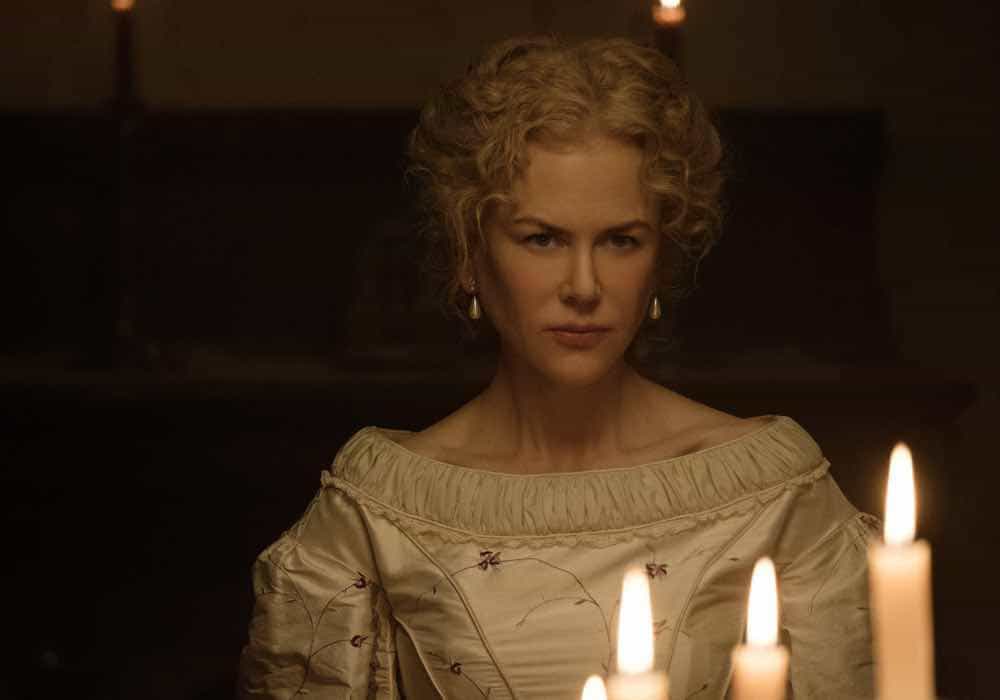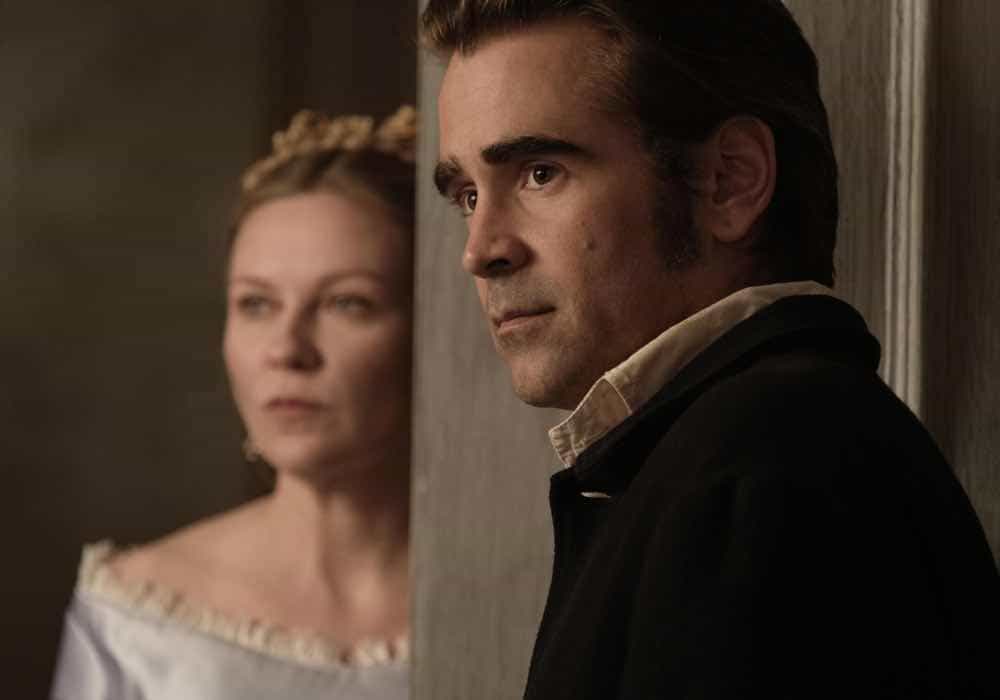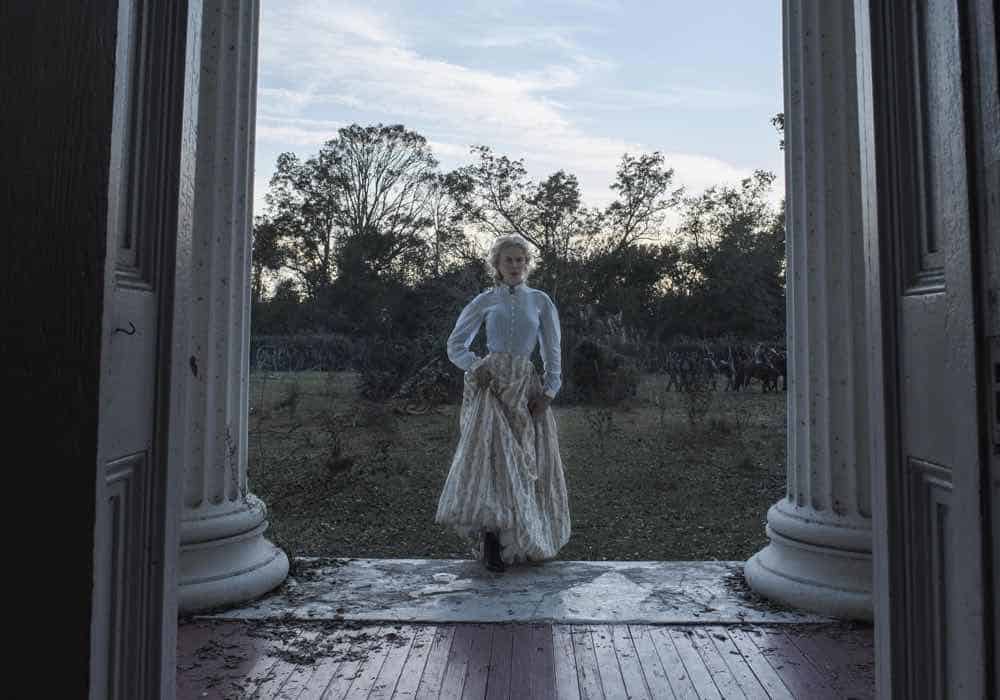In Sofia Coppola’s The Beguiled, violence erupts in Miss Martha’s seminary, poorly-defended citadel of virtue, but the women never lose their poise.

In the middle of the American Civil War, a young girl walks through the Virginia woods, humming contentedly to herself as muffled gunfire resounds in the background. Her calm is disturbed when she comes across a wounded Union soldier. Amy (a delightful Oona Laurence) supports Corporal McBurney (Colin Farrell) as they stagger back to her current home: the now half-deserted Farnsworth Seminary for young ladies. So begins Sophia Coppola’s The Beguiled, a new adaptation of the 1966 novel that was first adapted for screen in 1971. Coppola’s version of the story is aptly named: while you’re watching The Beguiled, you fall under its spell. It’s only afterward that you begin to sense, despite a few strong performances and Phillippe Le Sourd’s breathtaking cinematography, that something was missing.
Farnsworth Seminary is a refuge for five young women, instructor Edwina (Kirsten Dunst), and proprietress Miss Martha (Nicole Kidman). The white neoclassical mansion is at once a haven that’s been maintained against all odds, and a poorly-defended citadel of virtue. Though they are young teenagers, Miss Martha’s pupils aren’t girls — they are women in training. They are practicing. And they are all very pleased to have a handsome, helpless man about the place. Even the youngest girls put on their best jewellery and use pretexts, like delivering a prayer book, to flit in and out of the Corporal’s room. For a time, Corporal McBurney is a cat among the pigeons, drawing in his hosts by playing to their individual desires. But the balance of power starts to shift as he literally regains his feet. When he overextends himself, violence erupts, creating a standoff between the Corporal and the women, and disrupting the calm and peace Miss Martha has laboured to preserve.
[clickToTweet tweet=”‘The white neoclassical mansion is at once a haven and a poorly-defended citadel of virtue.'” quote=”‘The white neoclassical mansion is at once a haven and a poorly-defended citadel of virtue.'”]
Coppola sacrifices character development to give us a vivid sense of place. There’s not very much dialogue and almost no exposition. Scenes of characters interacting are palpably brief, even clipped. Sometimes it feels like a conversation or moment is just beginning to unfold when we’re hustled along. (Only the two longer dinner scenes feel like they’ve been allowed to play out fully.) At first, this heightens the sense of intrigue, but as the film goes on, it begins to feel incomplete.
[clickToTweet tweet=”In THE BEGUILED, Coppola sacrifices character development to give us a vivid sense of place. ” quote=”In THE BEGUILED, Coppola sacrifices character development to give us a vivid sense of place.”]
Coppola instead focuses on immersing us in the sensory elements of this little world, portraying Miss Martha’s seminary as an idyll. The film’s aesthetic is delicate rather than lush: all the women’s dresses are white or light coloured rather than practical black; the most common background music is birdsong. The dangers of war hover in the background but recede from our attention. Much of the film involves shots of mist rising through the Spanish moss hanging from the trees, or watching the girls go about quotidian tasks. Le Sourd’s almost painterly cinematography works much of the film’s magic in these still moments: light filtered through windows and branches bathes characters in a soft glow, and the grain of the film stock adds a hazy sensuality to every scene. Even though little is happening, the film never feels slow. Like Colonel McBurney, we are lulled by the beauty of the surroundings.
[clickToTweet tweet=” Le Sourd’s almost painterly cinematography works much of THE BEGUILED’s magic.” quote=”Le Sourd’s almost painterly cinematography works much of THE BEGUILED’s magic.”]
The Beguiled is at its most interesting when it examines the version of womanhood these young women are being raised to embody, in all its contradictions. Above all, they are to be creatures of beautiful and uninterrupted surfaces. Standards of grooming are rigorously maintained — the girls cook, keep watch, and garden (poorly) in spotless flowing skirts, always on the lookout for marauding soldiers. Although their world has been turned upside down, Miss Martha quietly enforces a routine of prayer, penmanship lessons, and performative virtue. The only reason Colonel McBurney is not handed over to the Confederate army, but instead is allowed to stay at the seminary to recover from his wounds, is because Amy invokes “Christian charity”.

Hypocrisy and erotic transgression don’t necessarily undercut this ideal, but are integrated into it. Each of the women, in her own way, tries to seduce the Corporal, whether her goal is a shared smile or a night in bed, because being sexually alluring is seen as a key part of their value. The appearance of delicacy is central: when the women discuss what to do about the newly volatile Corporal, any physical confrontation is rejected out of hand. But actual helplessness is unacceptable, because to fall apart in a crisis would be to lose one’s poise. The Beguiled reminds us that, decorative as these women may be, they are successfully surviving a war. When Miss Martha judges that McBurney’s wound will become gangrenous, the leg must be amputated. Never mind that she’s never done this before: “Bring me the saw! And get the anatomy book!”
The characterization is as sparse as the dialogue, and in some cases is frankly thin. Edwina remains a mystery. Dunst struggles to convey Edwina’s motivations without much help from the script: why is Edwina the only woman who feels imprisoned at Farnsworth Seminary, and why, if her father would help a Union deserter, can’t she simply rely on her family herself and leave? It feels like there’s important backstory we haven’t been given. Corporal McBurney, too, is sketchily drawn, but that’s the point: this movie isn’t about him, but how the women relate to him. What’s less forgivable is how little we learn about the women’s relationships with each other. I wanted to know more about the internal workings of Miss Martha’s school of genteel refugees, how they saw each other, and whether that changed when Corporal McBurney arrived in their midst. But Coppola seems more interested in a battle of the sexes than in the women themselves.
[clickToTweet tweet=”Coppola seems more interested in a battle of the sexes than in the women themselves. ” quote=”Coppola seems more interested in a battle of the sexes than in the women themselves.”]
There are exceptions: Elle Fanning is satisfyingly hatable as the odious Alicia. Beautiful, lazy, coquettish, prevaricating, and largely motivated by a sense of her own importance, we recognize her more from the tilt of her head as she stares at her own reflection than from anything she says or does to anyone else. Alicia’s motivations need to be plain in order to move the plot, but Fanning’s performance brings immediacy to a character that in lesser hands could be merely a plot device.

The film’s greatest treat is Miss Martha herself, whose graceful exterior conceals a steely self-sufficiency and resolve. Nicole Kidman can do more with less than any actress working. The way Miss Martha interacts with her charges, stretching out her arms to shield them from danger or keeping the dinner table conversation flowing during a murder, tells us more about her as a woman than we ever learn from her own lips. Her one moment of exposition comes over brandy, when Corporal McBurney lures her into reminiscing. Years ago, before this estate was her seminary, it was once a wealthy private home. We infer that Miss Martha grew up in this house — it belonged to her father and was left to her. This means that she never married, but it is impossible to imagine the magnetic Miss Martha (or the stunning Ms Kidman) as an old maid.
[clickToTweet tweet=”‘Miss Martha’s graceful exterior conceals a steely self-sufficiency and resolve.'” quote=”‘Miss Martha’s graceful exterior conceals a steely self-sufficiency and resolve.'”]
Conspicuously absent from Coppola’s script is any mention of the conflict that hangs over the film. The Beguiled is a civil war film divorced from, well, the civil war. There is only one reference to race: early on, one of the girls notes that the slaves have “run off”, which is presumably why these young ladies have to do the work of hoeing and cooking and keeping watch. Even Colonel McBurney is apolitical — he’s no Union patriot, but a fresh-off-the-boat Irishman who joined up for money and deserted as soon as he could.
[clickToTweet tweet=”These women are mounting a valiant rearguard action for an endangered and parasitic way of life.” quote=”These women are mounting a valiant rearguard action for an endangered and parasitic way of life.”]
But we know the South will lose the Civil War, and we know that the postwar world will be marked by tremendous upheaval and uncertainty. Seen in this light, Miss Martha’s seminary is more like a sanctuary where a dying model of womanhood is preserved against change. Her pupils seem like the last of their kind; the world they have been raised to inhabit no longer exists. We can hear the death of that old order in the muffled sounds of gunfire outside. Nevertheless, they are all — except perhaps Edwina — staunch in their commitment to a certain feminine ideal. Poised, sly, decorous, and ruthless, these women are mounting a valiant rearguard action for an endangered and ultimately parasitic way of life. At the end of the film, they retreat firmly behind the wrought-iron gate of the seminary, in their beautiful dresses, to wait.

